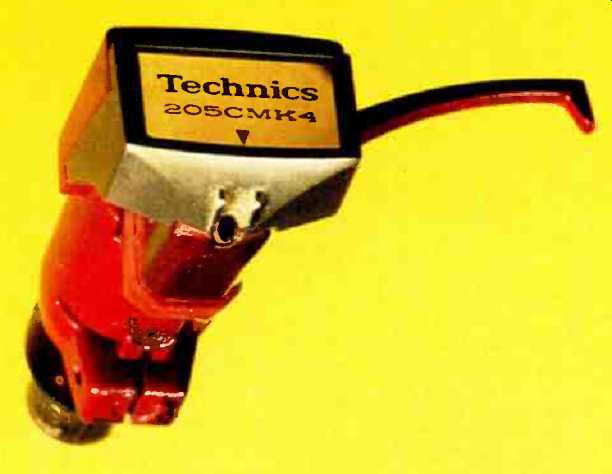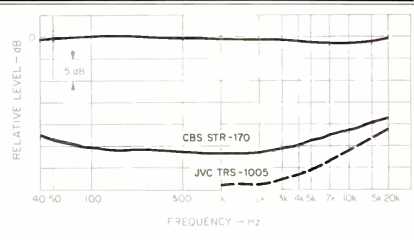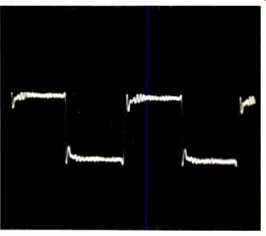
Manufacturer's Specifications:
Type: Moving magnet, with disc magnet and one-point suspension system; in "universal" plug-in headshell. (Also available as P-mount, without shell.)
Magnetic Circuit: All "HPF" core, precision-polished finish.
Cantilever: Tapered boron pipe.
Damper: TTDD (Technics Temperature Defense Damper).
Magnet: Neodymium; magnetic energy, (BH)max equals 35 mG-Oe.
Frequency Response: 5 Hz to 100 kHz; 15 Hz to 70 kHz, ±3 dB; 20 Hz to 15 kHz, ±0.5 dB.
Temperature Characteristics: 20°C, ±0.5dBat 10 kHz, ±2 dB at 20 kHz.
Output Voltage: 2.5 mV at 1 kHz at 5 cm/S, zero to peak, lateral velocity; 3.5 mV at 1 kHz at 5 cm/S, zero to peak, 45° velocity.
Channel Separation: Greater than e 25 dB at 1 kHz; greater than 20 dB at 10 kHz.
Channel Balance: Within 0.7 dB at 1 kHz.
Compliance: 12 x 10^-6 cm/dyne (100 Hz).
D.C. Resistance: 500 ohms.
Inductance: 240 mH. Impedance: 1.6 kilohms (1 kHz).
Recommended Load Resistance: 47 kilohms.
Recommended Load Capacitance: Less than 200 pF.
Stylus Tip: 0.2 x 0.7 mil, elliptical; 0.07-mm square-block diamond tip.
Effective Moving Mass: 0.109 mg.
Tracking Force Range: 1.25 grams, ± 0.25 gram.
Overhang Adjustment Range: 52 mm, ±3 mm.
Angle Range of Cartridge Inclination: ±2°
Replacement Stylus: EPS-205EP4.
Weight: 15.5 grams.
Price: $280; P-mount version (EPCP205CMk4), $250.
Company Address: One Panasonic Way, Secaucus, N.J. 07094.
The difficulty of installing and aligning phono cartridges is one of the major barriers to replacing and upgrading them, and there is a definite trend towards simplifying this process. Several conventionally mounted cartridges come with special alignment tools, and the plug-in P-mount system (which requires virtually no adjustment) is growing in popularity. But the oldest approach to the problem is to integrate the cartridge and the arm or headshell.
The Mk4 version of the Technics 205C moving-magnet cartridge exemplifies this trend. It is available both as a P-mount cartridge and integrated into a "universal" shell that fits all "S" or "J" shaped arms which accept a standard shell design. I tested the latter version. The primary advantage of this integrated type is the ease with which both the overhang and azimuth alignment can be set with a single screw.
The most significant improvement claimed for the Technics EPC-205CMk4 over the previous 205C models is its super-lightweight cantilever, made out of a tapered, pure boron tube; the metal has been crystallized and then processed into a cantilever with a laser beam. This design results in a dramatic reduction in the effective tip mass, which is 0.109 mg. My measurements confirm the extreme stiffness of the tiny cantilever tube, which measures 8 mils in diameter at the tip and only 10 mils near the disc magnet. Care should be exercised when handling the cartridge or placing the stylus on the record, inasmuch as pure boron is a bit brittle and the cantilever could be fractured if the stylus is dropped on a vinyl record more than three times or so.
The core material used in the magnetic circuit is "HPF" (a registered trademark), finely polished for superior high-frequency response to realize the flat transmission characteristics of an electric generator part. The armature magnet is made from neodymium--a trivalent metallic element of the rare-earth group-which has extremely strong magnetic energy [(BH)max equals 35 mG-Oe]. Butanol rubber is used for the damper on the majority of phono cartridges.
Its major drawback is that it is temperature-sensitive. Technics developed a special material for the damper, called "TTDD" (Technics Temperature Defense Damper), which is quite insensitive to temperature variations. The elliptical, nude-diamond stylus tip measures 0.2 x 0.7 mils and is only 4 mils across the flat area.
Like all Technics phono cartridges, the EPC-205CMk4 comes in a plastic box which also contains the usual assortment of mounting screws, stylus brush, screwdriver, and removable stylus guard. Also supplied is a printed frequency response curve which appears to be a general one but is actually made by the cartridge at hand, according to Technics.
Measurements
The EPC-205CMk4, which comes mounted in its headshell, was plugged into a fairly light S-shaped tonearm that is a part of the EDS 25F turntable. The Dennesen Geometric Soundtracktor was used to orient the cartridge in the headshell and tonearm.
Laboratory tests were conducted at an ambient temperature of 70° F (21.11° C) and a relative humidity of 70%, ±3%. The tracking force for all reported tests was set at 1.25 grams, and anti-skating force was 1.5 grams: The cartridge load was 47 kilohms and about 175 pF capacitance for all the tests. (The EPC-205CMk4 cartridge, incidentally, appears to be slightly capacitance-sensitive.) As is my practice, I made measurements on both channels, but only those for the left channel are reported unless there is a significant difference between the two channels, in which case both are reported.
Frequency response, using the CBS STR-170 test record, is +0.25,-1.5 dB from 40 Hz to 20 kHz (Fig. 1). Separation is 26.5 dB at 1 kHz, 20.5 dB at 10 kHz, and 19 dB at 20 kHz. Using the JVC TRS-1005 test record, frequency response from 1 to 20 kHz is practically identical to that using the CBS disc, but the separation from 1 to 20 kHz is not only better, but quite remarkable: 35 dB at 1 kHz, 25 dB at 10 kHz, and 22 dB at 20 kHz. These data indicate that the EPC-205CMk4 has excellent frequency response and very good high-frequency separation.
The 1-kHz square-wave response (Fig. 2) is relatively flat; the ringing shown is on the test record at about 42 kHz, and was probably generated by the cutter head when the master was cut. The arm/cartridge low-frequency lateral resonance is 5.5 Hz, and the vertical resonance is also 5.5 Hz; both were measured with the EDS tonearm.
The high-frequency resonance is at about 34 kHz. Despite the unusually low lateral and vertical resonant frequency, I did not hear any mistracking or distortion at any time. However, there seemed to be a hint of instability when some 12-inch, 45-rpm records were played.
Using the Dynamic Sound DMA-1 dynamic mass analyzer, I measured the arm/cartridge dynamic mass as 21 grams and the dynamic vertical compliance as 40 x 10^-6 cm/dyne at the vertical resonant frequency of 5.5 Hz.
The effective mass of the tonearm is 5.5 grams. The vertical stylus angle measured 24° for each channel. Lightly tapping the elevated tonearm elicited no microphonics, indicating that the cantilever assembly has an extremely low mass.

Fig. 1--Frequency response (top curve) and separation as measured by two
test discs (bottom curves).

Fig. 2--Response to a 1-kHz square wave.
The following test records were used in making the measurements: Shure TTR-103, TTR-109, TTR-110, TTR-115, and TTR-1 17; Columbia STR-100, STR112, and STR-170; JVC TRS-1005; Micro-Acoustics TT 2002; DIN 45.549; Ortofon 0001 and 0003, and EIAJ 31-1.
Other measured data are: Wt., 15.8 grams. D.C. resistance, 560 ohms; inductance, 240 mH. Opt. tracking force, 1.25 grams. Opt. anti-skating force, 1.5 grams. Output, 0.706 mV/cm/S. IM distortion (200/4000 Hz, 4-to-1): Lateral (+9 dB), 1.2%; vertical (+ 6 dB), 2.6%. Crosstalk, 26.5 dB with CBS STR-170 and 32 dB with Shure TTR-109. Channel balance, 0.5 dB. Trackability: High-freq. (10.8 kHz, pulsed), 30 cm/S; mid-freq. (1000 and 1500 Hz, lateral cut), 25 cm/S; low-freq. (400 and 4000 Hz, lateral cut), 30 cm/S. The 300-Hz test band of the DIN 45.549 test disc was tracked cleanly to 100 microns (0.01 cm) in the right channel and 120 microns (0.012 cm) in the left. This is quite an achievement for the cantilever; not so very long ago, 60 to 70 microns was considered very good for any cartridge. The EPC-205CMk4 was also able to play all the test bands on the Shure Obstacle Course Era Ill, Era IV and Era V test records, certainly another remarkable feat.
Use and Listening Tests
The equipment used in the listening tests included the Technics EPA-A250 (S-shaped) interchangeable tonearm, attached to the Technics EPA-B500 tonearm base and mounted on a Technics SP-10Mk11 turntable. Also used were the Audio-Technica AT666EX vacuum disc stabilizer, the Amber FF 17 preamplifier, two VSP Labs Trans-Mos 150 amplifiers (each used in the 300-watt mono mode), Discrete Technology speaker cable and interconnecting cable, a pair of B & W 801F loudspeakers, and the Technics SL-P10 CD player. Extensive listening tests were done before and again after the laboratory tests. In the pretest listening period, I also used the EDS-25F turntable with its own tonearm.
The low-frequency resonance of the EPC-205CMk4, in combination with the Technics tonearm described above, was 6 Hz. This is the same resonance frequency exhibited by all other recently tested cartridges when mounted in this arm, and ordinarily such a combination would have problems with record warps which cycle at about this frequency. However, at no time did I encounter any problem of mistracking or distortion during many hours of listening, whether I used the anti-resonance device or not-a tribute to the arm's design.
While listening to a wide variety of recordings, I noted, in particular, the excellent sonic clarity and lack of detectable coloration. Bass response was tight and well defined. Transient response and tracking ability, as well as applause definition, were excellent.
The cannon shots on the Telarc "1812 Overture," with their very high recorded velocity, were reproduced without a bit of difficulty-all sounded very natural. Stereo imaging and depth were very good. The human singing voice was reproduced rather well and sounded better than on many expensive phono cartridges. All in all, the EPC-205CMk4 acquitted itself rather well and sounded silky and pleasing.
As I had done on occasion in the past, I compared two analog records with their CD versions, where both had been derived from the same digital master tape. On Beethoven's Symphony No. 3 (Eroica) (O. Suitner, Staatskapelle Berlin, Denon OX-7202-ND PCM on LP and C-37-7011 on CD), the cartridge reproduced this recording quite accurately, as it did the Mussorgsky "Pictures at an Exhibition" and "Night on Bald Mountain" (L. Maazel, Cleveland Orchestra, Telarc 10042 on LP and CD-80042 on CD). After having played numerous recordings, I am firmly convinced that Technics' moderately priced EPC205CMk4 is a genuinely "musical" phono cartridge that faithfully reproduces every nuance present on a record. Anyone looking for an excellent phono cartridge at a moderate price should consider it a superb choice.
-B. V. Pisha
(Source: Audio magazine, Jan. 1986)
Also see: Technics SP-10MK3 Turntable (Feb. 1985)
Stanton Model 881S Stereo Phono Cartridge (Nov. 1978)
= = = =